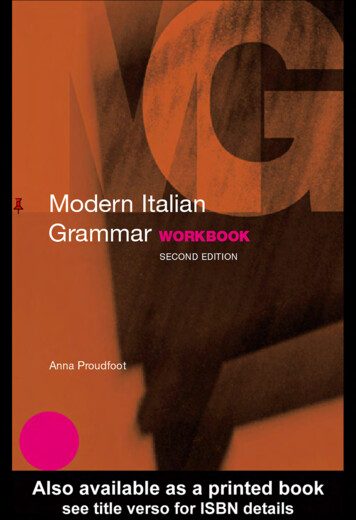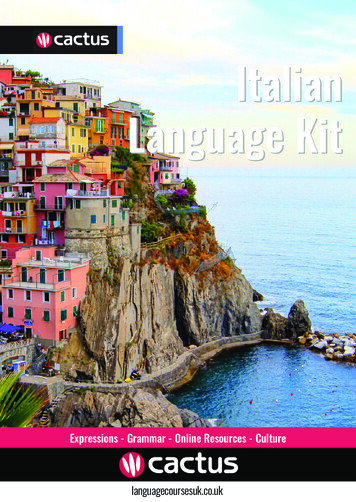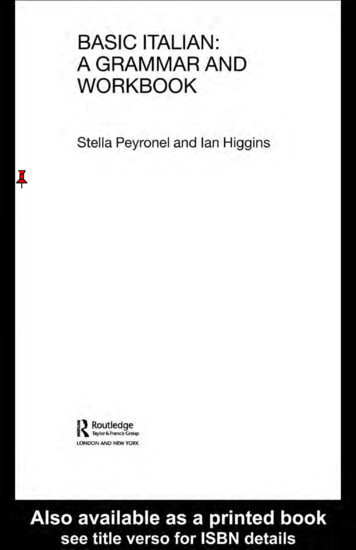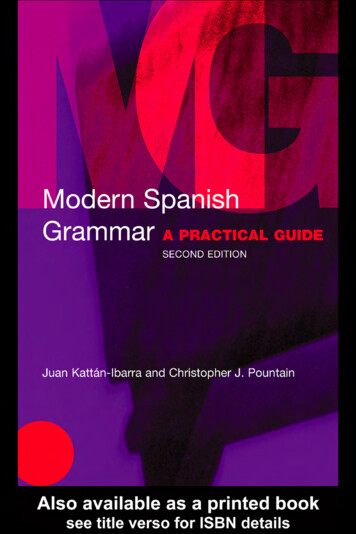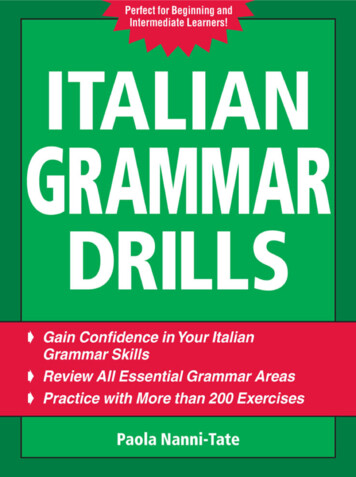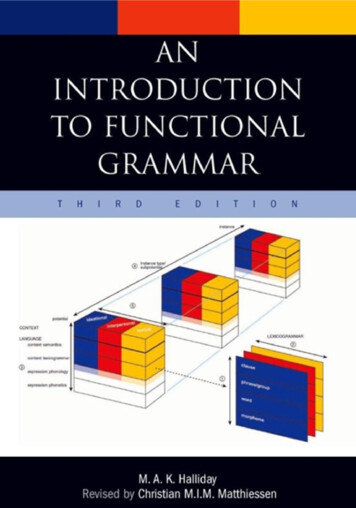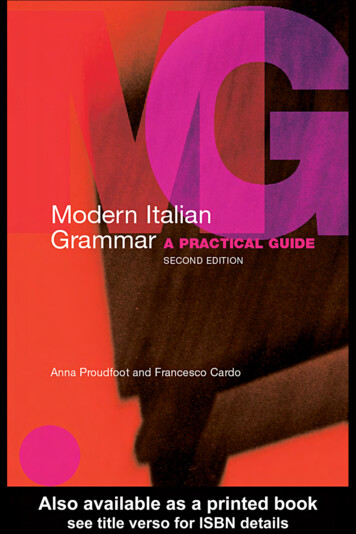
Transcription
6789401234567850123111ModernITALIANGrammarSecond Edition
Routledge Modern GrammarsSeries concept and development – Sarah ButlerOther books in series:Modern German Grammar, Second EditionModern German Grammar Workbook, Second EditionModern Spanish Grammar, Second EditionModern Spanish Grammar Workbook, Second EditionModern French Grammar, Second EditionModern French Grammar Workbook, Second Edition
6789401234567850123111ModernITALIANGrammarA practical guideSecond EditionAnna Proudfootand Francesco Cardo
First published 1997by RoutledgeSecond edition published 2005by Routledge2 Park Square, Milton Park, Abingdon, Oxon OX14 4RNSimultaneously published in the USA and Canadaby Routledge270 Madison Ave, New York, NY 10016This edition published in the Taylor & Francis e-Library, 2005.“To purchase your own copy of this or any of Taylor & Francis or Routledge’scollection of thousands of eBooks please go to www.eBookstore.tandf.co.uk.”Routledge is an imprint of the Taylor & Francis Group 1997, 2005 Anna Proudfoot and Francesco CardoAll rights reserved. No part of this book may be reprinted orreproduced or utilised in any form or by any electronic, mechanical,or other means, now known or hereafter invented, includingphotocopying and recording, or in any information storage orretrieval system, without permission in writing from the publishers.British Library Cataloguing in Publication DataA catalogue record for this book is available from the British LibraryLibrary of Congress Cataloging in Publication DataProudfoot, Anna.Modern Italian grammar: a practical guide/Anna Proudfoot andFrancesco Cardo. – 2nd ed.p. cm. – (Routledge modern grammars)Includes index.1. Italian language – Textbooks for foreign speakers – English.2. Italian language – Grammar. I. Cardo, Francesco, 1951–II. Title. III. Series.PC1129.E5P76 2005458.2′421 – dc222004026099ISBN 0–415–33483–7 (hbk)ISBN 0–415–33164–1 (pbk)
6789401234567850123111ContentsIntroductionHow to use this bookGlossaryPart AxiiixvxviiStructures1The noun group1.11.21.31.41.523General features of verbs 22Verb tables 31Moods and tenses of verbs 3965What is a pronoun? 65Personal pronouns 65Stressed personal pronouns 65Unstressed personal pronouns 67Relative pronouns 72Interrogative pronouns and adjectives 74Possessive pronouns and adjectives 75Demonstrative pronouns and adjectives 77Indefinite pronouns and adjectives .43.53.63.73.83.94What is a noun? 3The noun 3The article 10The adjective 14Agreement of noun, article and adjective 20Verbs2.12.22.33What is a preposition? 84Combined prepositions and articles 85Use of prepositions with nouns 85Use of prepositions with verbs 89Other prepositions 9184
CONTENTS5Conjunctions5.15.25.36798What is an adverb? 98Types of adverbs 98Comparative and superlative adverbs 101Numbers7.17.27.37.47.57.67.77.87.97.107.11Part BWhat is a conjunction? 93Coordinating conjunctions 93Subordinating conjunctions 95Adverbs6.16.26.393103What is a number? 103Cardinal numbers 103Ordinal numbers 104Calculations 106Percentages 106Collective and approximate numbers 106Dates 107Time 108Weights and measures 108Currency 109Table of numbers 109FunctionsIGiving and seeking factual information8Identification: giving personal information8.18.28.38.48.58.6910123Introduction 123Specifying a known or particular person or object 123Specifying category or type 124Specifying ownership 125Describing people or things10.110.210.310.410.510.610.7viIntroduction 115Tu or Lei? 115Giving different kinds of personal information 116Emphasising the person referred to 120Eliciting personal information 120Dialoghi 121Specifying people or objects9.19.29.39.4115Introduction 127Physical characteristics 127Non-physical attributes 130Intensifying the meaning of the adjective 133Diminishing the strength of the adjective 134Describing a physical state using stare 135Dialogo 136127
11112345678940123456785012311111Talking about existence, presence and availability13711.111.211.311.4Introduction 137Talking about existence and/or presence 138Talking about occurrence 139Talking about presence, attendance and participationat an event 14111.5 Talking about availability 14111.6 Expressing ‘some, any’ 14211.7 Specifying the quantity available 14411.8 Expressing ‘something, anything’, ‘someone, anyone’ 14511.9 Specifying location, time or frequency 14511.10 Expressing non-existence or non-availability 14612Talking about the present12.112.212.312.412.513Speaking/writing about the troduction 173Asking a question using interrogative intonation 173Asking a question using interrogative words 173Dialogo 176Negative sentences16.116.216.3167Introduction 167Using the future tense 167Using the present tense 167Expressing the immediate or very near future 168Expressing the English ‘going to’ 168The ‘past in the future’ 169The future seen from the past 169Some expressions of time in the future 170Expressing intention and future plans 172Asking questions15.115.215.315.4154Introduction 154The perfect aspect 155Using the passato prossimo 156Using the passato remoto 157Expressing the imperfect aspect 158Combinations of perfect and imperfect aspect 161Present tense expressing past 165Indicators of time 165Talking about the duction 149Describing present situations, actions and events 149Expressing ongoing actions 151Words and phrases indicating present time 151Dialogo 152Introduction 178Reinforcing a negative statement 178Expressing negation and time non . . . più, non . . . mai 179178
19.6II188Introduction 188Using a pronoun to refer back 188Using a pronoun: referring to the subject of an action 188Using a pronoun: referring to someone other thanthe subject 188Referring to someone or something using questo, quello 192Using indefinites to refer to ‘someone/something’ 192Referring to something or someone mentioned 193Referring to what has been said or will be said 193Focusing on the action19.119.219.319.4183Introduction 183Using comparative adjectives and adverbs 183Expressing ‘than’ 184Expressing ‘which’ 186Expressing different degrees of intensity 186Referring to objects and people18.118.218.318.419né . . . né 179niente, nulla 180the adjective nessun/o/a 180the pronoun nessuno/a 181Comparisons and degrees of intensity17.117.217.317.417.518Expressing negation usingExpressing negation usingExpressing negation usingExpressing negation usingReinforcing negation 181194Introduction 194Focusing on the action using the passive 194Situations when the passive is not used 197Focusing on the action using si passivante (passive formwith si) 199Si impersonale (impersonal si) 200Focusing on the object of the action 200Actions affecting ourselves and others20Social viiiGreeting, welcoming 203Introducing oneself and others 204Saying goodbye 205Wishes 206Expressing and receiving thanks, appreciation 206Compliments 207Making and accepting excuses, apologies 207Expressing commiseration, sympathy 208Using titles, salutations 208Getting other people to do things21.121.221.3203Introduction 211Giving orders and commands 211Making negative requests and commands 213211
21.922Permission and possibility22.122.222.322.423III225Need or want 225Expressing wants 225Expressing needs 227Suggesting, proposing, advising and recommending24.124.224.324.424.524.6221Asking or granting permission 221Denying permission 222Speaking about the ability or opportunity to do something 222Making a request 223Expressing need, obligation or desire23.123.223.324Written instructions and recipes 213Asking someone to do something 216Giving an order using ‘command’ verbs 217Far fare, lasciar fare construction 217Using persuasion 218Monologo 219229Giving advice 229Making or receiving a suggestion 230More expressions of advising or suggesting 232Advising someone not to do something, giving a warning 233Asking for advice 233Other ways of making suggestions 234Expressing emotions, feelings, attitudes and opinions25Expressing emotions: positive, negative, neutral25.125.225.325.425.525.62627ix253Expressing or seeking an opinion or belief 253Expressing agreement, disagreement 255Indicating preference, likes and dislikes28.128.2248Introduction 248Expressing hope 248Expressing fear, pessimism or regret 249Expressing doubt 251Expressing an opinion or belief, agreementor disagreement27.127.228Introduction 237Interjections (positive, negative, neutral) 237Expressing positive emotions 238Expressing negative emotions 241Expressing neutral emotions 245Expressing positive and/or negative emotions 247Expressing emotions: hope, fear, doubt26.126.226.326.4237Introduction 258Expressing likes 258258
CONTENTS28.328.429Expressing certainty and knowledge29.129.229.329.429.529.6IVExpressing dislikes 260Expressing a preference 262263Introduction 263Sapere 263Essere certo, sicuro, convinto 264Non certo, poco certo, incerto 265Pensare, credere, sembrare, parere 266Ricordare, dimenticare 266Putting in context30Combining tion 297Purpose involving only the subject of the action 297Purpose involving someone or something else 299Purpose attached to a person/object 300Expressing causes and tion 294Certainty, uncertainty 294Knowing, not knowing 295Possible or impossible, probable or improbable 295Evident, obvious 296Expressing purpose33.133.233.333.4287Introduction 287Quoting: direct speech 288Reporting: indirect speech 289Reporting information or quoting hearsay 291Expressing possibility and probability32.132.232.332.432.533Introduction 271Combining messages of equal importance 271Combining messages of unequal importance 274Setting events in a time context 274Relationship of main clause and dependent clauses 275Relationship of tenses in complex texts 279Quoting or reporting events and hearsay31.131.231.331.4271Introduction 302Specific people, factors or events responsible 302General cause or reason 302Il motivo, la causa, la ragione 305Causare, provocare, suscitare 306Dovere, dovuto 306Asking why 306Using the imperfect tense to give reasons 307302
11112345678940123456785012311135Expressing result, effect and ion 327Expressing a real possibility 327Expressing a condition unlikely to be met or impossible 328Expressing conditions with other conjunctions 329Expressing conditions with gerund, infinitive or participle 330Unfinished conditional sentence 331Other uses of se 332Expressing reservation, exception and concession39.139.239.3321Introduction 321Place: adverbs 321Place: prepositions 322Manner 324Expressing a condition or ion 313Expressing same time context 313Expressing earlier time context 314Expressing later time context 315Defining the limits of a period: ‘since’/‘until’ 317Specifying repetition and frequency 319Other expressions of time 320Place and manner37.137.237.337.438Introduction 308Coordinating conjunctions 308Conclusive (result) conjunctions 309Così, tale, tanto, troppo 310Words expressing result, effect 311Specifying time36.136.236.336.436.536.636.7308333Introduction 333Expressing reservation or exception 333Modifying a statement by concession 334Expanding the horizons40Registers and style40.140.240.340.440.540.640.741xiIntroduction 341Spoken and written discourse 341Differences in lexis 342Differences in syntax 343Informal written communication 346Formal and informal registers 347Word order 349Oral communication and telephone skills41.141.2341Introduction 352The Lei form 352352
CONTENTS41.341.441.541.641.741.842Written ns 354Discourse markers 354Techniques of oral communication 356Spelling on the telephone 357Telephone phrases 358On the telephone 360362Introduction 362Letters and faxes 362Curriculum vitae 365Extended writing: differences between English and Italian 367Writing essays, making connections 367Reports 367Bureaucratic language 371Scientific and technical language 372Journalistic language 373I:II:III:IV:Spelling and pronunciationIrregular verbsSequence of tensesVerbs and prepositions376381389390396
6789401234567850123111IntroductionModern Italian Grammar follows an entirely new approach to learning Italian. Itembraces a new way of looking at grammar – seeing it not as the ultimate goal, butas the tool with which we construct a dialogue or a piece of writing.Modern Italian Grammar is specifically designed to be accessible to the English readernot brought up in the Italian tradition of grammar and language analysis. It isunique both in its combination of the formal grammar reference section and theguide to usage organised along functional lines, and because it has been compiledby an English mother-tongue teacher of Italian and an Italian native speaker, workingclosely together.It is the ideal reference text to use with newer language courses, for both beginnersand advanced learners.The course books and textbooks published over the last two decades are based onthe principles of the communicative approach to language learning, which recognisesthat the objective of any language learner is to communicate, to get one’s messageacross, and that there can be many different ways of doing this, rather than a ‘right’way and a ‘wrong’ way.The communicative approach emphasises language functions rather than structures.Traditional reference grammars present language by structure, making them inaccessible to learners who have no knowledge of grammatical terminology. Modern ItalianGrammar presents language by function, with examples of usage and full explanations of how to express specific functions in Part B. At the same time it retains thetraditional presentation of language by structure in Part A, which illustrates languageforms and grammatical systems in a schematic way: word formation and morphology,verb conjugations, tenses, use of conjunctions and verb constructions.The language functions included have been based on the communicative functionslisted in Nora Galli de Paratesi’s Livello Soglia (1981), itself based on J.A. van Ek’sThe Threshold Level (1975), the statement of key language functions supported bythe Council of Europe. We have expanded them to provide a richer variety of examples more suited to our target readership. The division into functional areas alsotakes account of general linguistic notions, which can occur in more than one function; these include notions such as presence or absence, time and space, cause andeffect. Notions and functions are integrated throughout Part B, while the structuresillustrated in Part A are accessed through extensive cross-referencing.xiii
INTRODUCTIONIn our choice of examples, we have included as many different contexts as possible.Some examples are typical of everyday dialogue or writing; some have been takenfrom the press or television, others from contemporary texts.Our guides and inspiration in putting together this grammar have been some of therecognised authorities in the area of Italian grammar in the last decade or so: tothem go our thanks and our recognition of the great debt we owe them: Anna-Lauraand Giulio Lepschy (The Italian Language Today, Routledge, 1991); Marcello Sensini(Grammatica della lingua Italiana, Mondadori, 1990); Maurizio Dardano and PietroTrifone (Grammatica Italiana, 3rd edn, Zanichelli, 1995); Luca Serianni (Grammaticaitaliana. Italiano comune e lingua letteraria, 2nd edn, UTET, 1991); Giampaolo Salviand Laura Vanelli (Grammatica essenziale di riferimento della lingua italiana, De Agostini/Le Monnier, 1992).The last three texts in particular have departed from traditional Italian grammarterminology to some extent. In Modern Italian Grammar we too have made innovations both in terminology and in presentation. In many cases we have had to makechoices, and there may be areas where our choices differ from those of our colleagues.One such area is terminology.We have deliberately departed from the practice of translating passato remoto as‘past definite’ or ‘past historic’, since this only reinforces in the learner’s mind theidea that the passato remoto should be used to describe events far off in time, whilethe passato prossimo is used for more recent events – a concept which misleads.We have followed Salvi and Vanelli in defining the former as ‘simple perfect’ (perfettosemplice) and the latter as ‘compound perfect’ (perfetto composto) which betterillustrates the difference in these verb forms, and at the same time brings the focusback to the important distinction between perfect and imperfect.In conclusion, we are conscious of the fact that our grammar represents the beginning of a journey rather than an end. We have had to find our own way, and makeour own judgements, in an area as yet uncharted. We may have erred on our way,but hope we have not foundered totally. We trust that our colleagues will be forgivingof any shortcomings. In this second edition of Modern Italian Grammar we haveincorporated suggestions from readers and reviewers and updated the examples takenfrom the press, particularly in the later chapters, and the chapters on Writing, Oralcommunication, and Registers and style.We’d like to thank our editors Sophie Oliver and Sarah Butler for their patience andsupport, and our students, colleagues and friends for their useful and positive feedback. Thanks also to our families in Oxford and Naples for putting up with theendless journeys back and forth.Finally we wish our readers ‘Buono studio’.Anna Proudfoot and Francesco Cardoxiv
6789401234567850123111How to use this bookPart A of the book is a reference guide to the grammatical structures or ‘buildingblocks’ of Italian: noun group, verbs, pronouns, conjunctions, prepositions andadverbs. Where possible, tables are used to illustrate forms and patterns.Part B shows how grammar structures are used to express communicative ‘functions’,such as giving personal information, asking someone to do something, describingsomething, etc. These structures are divided into four broad sections: I Giving andseeking factual information; II Actions affecting ourselves and others; III Expressingemotions, feelings, attitudes and opinions; IV Putting in context. A final section,Section V Expanding the horizons, looks at special types of language, for examplethe formal register, bureaucratic language, and the language of telephone and letter.The table of contents at the front of the book shows the content of each sectionand chapter, for Part A and Part B. It is not in alphabetical order but set out accordingto the layout of the book.At the end of the book, there is a full index: grammar structures, communicativefunctions and keywords are all listed in alphabetical order, using both Italian andEnglish terms.If you want to know how to express a particular function, for example ‘Asking ifsomething is available’ or ‘Introducing yourself’, simply look it up in the index orin the table of contents. In Part B, you will find all the different ways in which youcan say what you want, with an indication of where you can find further information on the grammar structures used, and also references to related functions foundin other parts of the book.If, on the other hand, you know the grammatical name for the structure you wantto use, for example personal pronouns or impersonal si, you can look that up inthe index instead. You will find each grammar structure explained in Part A. Part Ais also useful as an easy-to-use quick reference section, where you can remind yourself of the correct form, or check on a verb ending, for example. A glossary, whichimmediately follows this short guide, gives definitions of the grammatical terms usedin the book, with examples.Note that throughout the book an asterisk is used to denote a form or wording thatdoes not actually exist or is incorrect, shown only to demonstrate a point.Lastly, Italian and English keywords are indexed to make it easier for the reader tolook up a particular point. Grammar terminology as well as Italian examples arexv
HOW TO USE THIS BOOKlisted in the index (for example, you will find both lei and ‘personal pronouns’).We hope you enjoy learning Italian using this book as a guide. Remember that somespoken skills such as pronunciation, intonation and stress cannot simply be learnedfrom a book. But grammar structures are the foundation of any language, and thisbook will teach you how to use these structures to express what you want to say.Anna Proudfoot and Francesco Cardo, 2005xvi
6789401234567850123111GlossaryAbstract nounOne which refers to a concept or quality rather than a person or object. Examplesare: la felicità ‘happiness’; la miseria ‘poverty’.Active constructionAn active construction is a sentence in which the subject of the sentence is theperson carrying out the action, or the event taking place (as opposed to a passiveconstruction where the subject is the person affected by the action): mio maritofuma troppo ‘my husband smokes too much’; gli ospiti rimangono fino a sabato‘the guests are staying until Saturday’. A verb can therefore have an active form(chiudiamo la porta a mezzanotte ‘we shut the door at midnight’) or a passiveform (la porta viene chiusa a mezzanotte ‘the door is shut at midnight’).AdjectiveAdjectives describe or give information about a noun. They can be descriptive (suchas grande ‘big’, bianco ‘white’, vecchio ‘old’, italiano ‘Italian’), demonstrative(questo ‘this’, quel ‘that’), indefinite (qualche ‘some’, alcuni ‘some, a few’, certo‘certain’), interrogative (quale ‘which’, quanto ‘how much, many’) or possessive(mio ‘my’, tuo ‘your’, etc.): alcuni nostri amici ‘some friends of ours’; la vecchiacasa in campagna ‘the old house in the country’.AdverbAdverbs give information about a verb, saying, for example, how something is done:bene ‘well’; male ‘badly’; subito ‘immediately’; cortesemente ‘politely’. They canalso add further information about an adjective or another adverb: tanto stanco ‘sotired’; poco bene ‘not very well’; molto male ‘very badly’.AgreementIn Italian, adjectives, articles and in some cases past participles have to ‘agree’ withthe noun or pronoun they accompany or refer to. This means that their form variesaccording to whether the noun/pronoun is masculine or feminine (gender) andwhether it is singular or plural (number): la casa bianca ‘the white house’; i mieisandali sono rotti ‘my sandals are broken’; loro sono andati ‘they went’.ArticleItalian has three types of article: the definite article il, lo (etc.) ‘the’; the indefinitearticle un, una (etc.) ‘a’; and the partitive dei, delle, degli (etc.) ‘some, any’. (Forexample: il ragazzo ‘the boy’; una lezione ‘a lesson’; dei bambini ‘some children’.)xvii
GLOSSARYAuxiliary verbAuxiliary verbs such as avere, essere are used in combination with the past participleto form compound tenses, both active (Ho mangiato ‘I have eaten’, siamo andati‘we have gone’) and passive (è stato licenziato ‘he was sacked’). See also modalauxiliaries.ClauseA clause is a section or part of a sentence that contains a subject and a verb. Complexsentences are made up of a series of clauses. The main clause (or clauses) is the partof a sentence that makes sense on its own and does not depend on any otherelement in the sentence. A subordinate clause always depends on another clause,and is often introduced by a conjunction such as che. There are different types ofsubordinate clause, for example: relative clauses, Ho visto il ragazzo che piace amia sorella ‘I saw the boy that my sister likes’; or purpose clauses, Ha portato lamacchina dal meccanico perché controllasse i freni ‘I took the car to the mechanicso that he could check the brakes’.ComparativeWhen one person, object or activity is compared with another a comparative formis used: mia figlia nuota meglio della sua ‘my daughter swims better than hers’;la pasta napoletana è migliore di quella siciliana ‘Neapolitan pasta is better thanSicilian pasta’.Compound nounA compound noun is a noun formed by joining together one or more words, eithernouns or other parts of speech: asciugamano ‘a towel’ (verb asciugare ‘to dry’ noun mano ‘hand’); capotreno ‘chief guard on train’ (noun capo ‘chief’ nountreno ‘train’).Compound tensesCompound tenses are tenses consisting of more than one element. In Italian, thecompound tenses are formed by the auxiliary avere or essere, and the past participle:ho mangiato troppo ‘I have eaten too much’; siamo andati a casa ‘we went home’.See also Simple tenses.ConditionalThe conditional is not strictly a tense, but a verb mood. It can be used on its own,particularly as a polite way of expressing a request: Le dispiacerebbe aprire lafinestra? ‘Would you mind opening the window?’. It can also be used in conditional sentences, where the meaning of the main sentence is dependent on somecondition being fulfilled: Andrei in vacanza anch’io, se avessi tempo ‘I would goon holiday too if I had the time’.ConjugationThis refers to the way in which verb forms change according to the person, tenseor mood: (io) vado ‘I go’; (noi) andremo ‘we will go’; le ragazze sono andate ‘thegirls went’; voleva che io andassi a casa sua ‘he wanted me to go to his house’;etc. The word conjugation is also used to mean the regular patterns of verbs endingin -are, -ere, -ire to which verbs belong.ConjunctionA linking or joining word, usually linking two words, phrases or clauses within asentence: Marco e Davide ‘Marco and Davide’; con amore ma con disciplina ‘withxviii
111123456789401234567850123111love but with discipline’; sono andata a letto perché ero stanca ‘I went to bedbecause I was tired’; i giudici dicono che bisogna cambiare la legge ‘the judgessay that the law should be changed’. Conjunctions can either be coordinating, linkingtwo phrases or clauses of equal weight, or subordinating, linking a main clause andsubordinate clause.CountableA noun is countable if it can normally be used in both singular and plural, andtake the indefinite article un, una (etc.): un bicchiere ‘a glass’; una pizza ‘a pizza’.Whereas an uncountable noun is one which is not normally found in the plural(e.g. zucchero ‘sugar’) or an abstract noun (such as tristezza ‘sadness’).DeclensionThis means the way in which nouns and adjectives decline (in other words, changetheir endings according to whether they are singular or plural, masculine or feminine): un ragazzo ‘a boy’; una ragazza ‘a girl’; due ragazzi ‘two boys’; due ragazze‘two girls’. This pattern of endings is known as the declension.Definite article: see Article.DemonstrativeA demonstrative adjective or a pronoun is one which demonstrates or indicates theperson or object being talked about: questo carrello ‘this trolley’; quel professore‘that teacher’; quelle tagliatelle ‘those tagliatelle’.Direct objectA direct object, whether noun or pronoun, is one which is directly affected by theaction or event. A direct object can be living or inanimate. It is always used witha transitive verb: i miei figli hanno mangiato tutti i cioccolatini ‘my sons ate allthe chocolates’; li ho visti in città ieri sera ‘I saw them in town yesterday evening’.Feminine: see Gender.Finite verbA verb that has a subject and is complete in itself, as opposed to infinitives orparticiples, which have to depend on another verb: ieri siamo andati in piscina‘yesterday we went to the swimming pool’; domani i ragazzi torneranno a scuola‘tomorrow the kids will go back to school’.GenderAll nouns in Italian have a gender: they are either masculine or feminine, even ifthey are inanimate objects. Even where living beings are concerned, grammaticalgender is not always the same as natural gender: una tigre ‘a tiger’ (either sex unlessspecified); un ippopotamo ‘a hippopotamus’. Gender is important since it determines the form of noun, the article and adjective.GerundA gerund is a verb form ending in -ando or -endo: parlando ‘speaking’; sorridendo‘smiling’; finendo ‘finishing’. The gerund is most often used in Italian along withthe verb stare to express a continuous action or event: sto finendo ‘I’m just finishing’;stavano ancora mangiando ‘they were still eating’. The nearest equivalent in Englishis the ‘-ing’ form but it is not used in exactly the same way.IdiomaticAn idiomatic expression is one that cannot normally be translated literally, for example ubriaco fradicio literally ‘soaking drunk’ but more idiomatically ‘dead drunk’.xix
GLOSSARYImperativeThe imperative mood is the verb mood used to express orders, commands or instructions: state fermi ‘keep still’; si accomodi ‘sit down’; andiamo ‘let’s go’. (See alsoSubjunctive.)Impersonal (verbs, verb forms)Impersonal verbs or verb forms do not refer to any one particular person. They cangenerally be translated by the English ‘it’ form and use the third person form: occorrepulire prima la casa ‘It is necessary to clean the house first’; non serve protestare‘it’s no good protesting’. These verbs can be personalised by the addition of a personalpronoun, usually the indirect object: non mi occorre questo maglione ‘I don’t needthis thick swea
Modern ITALIAN Grammar A practical guide Second Edition Anna Proudfoot and Francesco Cardo 1 2 3 4 5111 6 7 8 91

